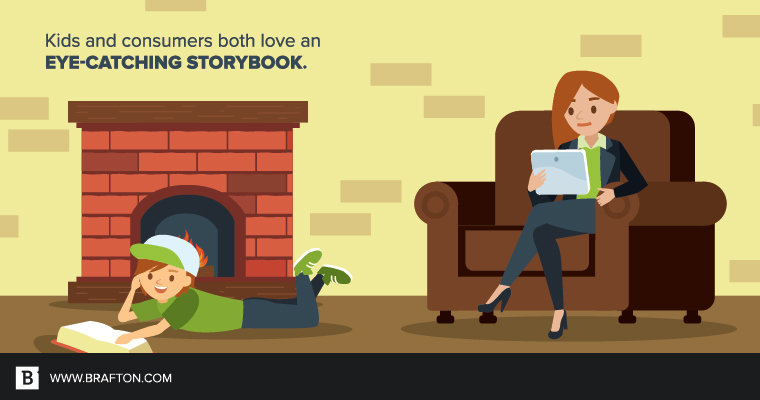Unless action figures and juice boxes are your raison d’être, chances are children aren’t your target marketing audience. Still, the adults who purchase your products and services have plenty in common with kids, including a fondness for storybooks with lots of pictures.
Data shows modern consumers crave content marketing, with nearly half of business-to-business buyers viewing three to five pieces of content before engaging with sales representatives. And, you guessed it, eBooks are among the top performers in terms of content assets. A 2016 report showed sixty-seven percent of B2B consumers reported they used eBooks within the past year to make a purchasing decision.
Beyond educating prospective clients, eBooks also present ample opportunity to capture leads. By gating these assets and requiring readers to provide personal details in exchange for a free download, you’re generating valuable sales information while pushing consumers down the sales funnel.

That said, crafting an effective eBook means more than slapping charts and graphs over text. Melding thorough research, tailored messaging and dazzling design, successful eBooks require careful planning and collaboration.
Taking care with text
Unlike white papers, which represent deep dives into subjects on par with research papers, eBooks are meant to be highly digestible assets that get straight to the point. An effective eBook should have no more than 150 words per page maximum, with 125 representing the sweet spot.
As far as length, 10 pages serves as a standard benchmark, offering you a chance to provide valuable information without putting your reader to sleep. While slightly shorter or longer eBooks are OK, you must balance providing an asset worth a person’s time with not taking up too much of it.
For writers, the greatest challenge is fitting all necessary information in a limited amount of space. This means that in addition to topic ideation, writers must work with appropriate stakeholders to zero in on the overarching goal of the eBook and its specific messaging. From there, an outline should be created to map out exactly what each page of the asset will contribute and how. Once text is approved, the real fun begins.
Bringing your eBook to life
eBooks are, first and foremost, visual marketing assets. While the text is integral, the imagery is the star of the show. The real art, however, is how designers marry the two concepts.
“It’s really all in the text,” said Courtney Meyer, Senior Designer at Brafton. “We read the outline first, to get a sense of the subject matter and make sure we fully understand what the topic is about. From there, we pull out keywords that give some sense of imagery in our heads. With that imagery, we can then do research to find a theme.”
While you may have thoughts in mind regarding the messaging of the eBook, it’s often more difficult to provide specific guidance regarding imagery. Fortunately, designers tend to be a crafty bunch. If you’re unsure where to begin with visuals, Courtney recommended scoping out your existing collateral to see how your new asset can fit with your current branding.
“We always check out client websites to see what their graphic style is,” she said. “Some clients have awesome websites and an existing illustration style we can draw from. Other times, there may not be so much. We have to inspect their websites – look at the code – and find hex codes for colors, and any fonts they may use. That’s our starting point.”
Once theme and style are taken care of, and client branding is procured, Courtney determines the proper layout for the asset. Considerations such as cover pages, tables of contents and more must be taken into account. Then, attacking the asset page by page, she’s also able to ratchet up engagement through digital design methods.
“In addition to adding font styles, colors, illustrations and photos, we can create buttons in our design software for interactivity,” she said. “We sometimes do this in the table of contents, which helps readers navigate the eBook better.”
“People would much rather read a fun, interactive eBook than a wall of text.”
The art of cooperation
In content marketing, departments are all too often siloed, working separately instead of in concert. As far as eBooks are concerned, this is a dangerous road to travel. Designers and writers must collaborate to ensure the finished product not only fulfills a specific marketing vision, but follows proven best practices.
“Personally, I shut down when I see too much text on a page,” Courtney said. “You need to keep your reader interested, and that means making things as concise as possible. Designers also need room to add imagery, or create cool layouts on a page. It’s important for editorial and design departments to work together to make it happen.”
It’s vital not to lose sight of your eBook’s overarching objective. Whether you’re in the market for thought leadership, brand awareness or audience education, don’t forget why you’re using eBooks in the first place.
“In general, people would much rather read a fun, interactive eBook that keeps them engaged rather than a wall of text,” Courtney said. “eBooks are specifically designed for this experience. Ultimately, you’re trying to draw in customers. You want to make them say, ‘wow.’”
Don’t believe us? Set down “War and Peace” next to “The Cat in the Hat” and see which one a child grabs first. Some story time lessons last a lifetime.





